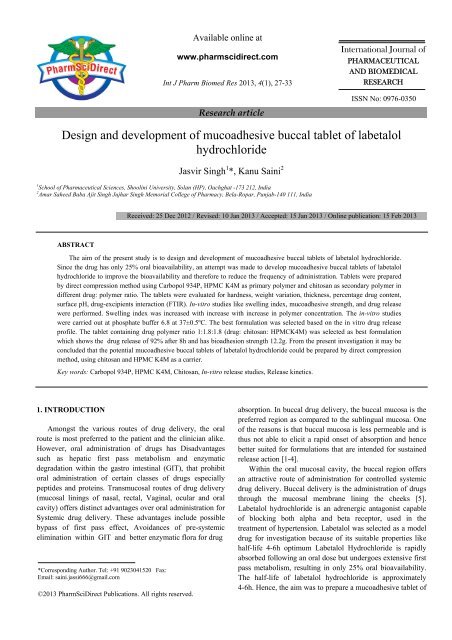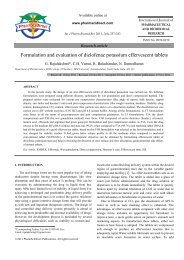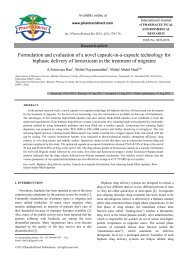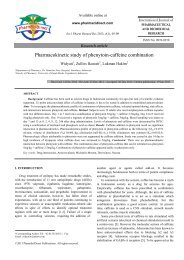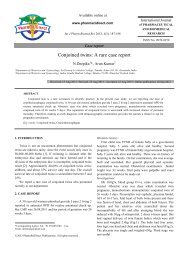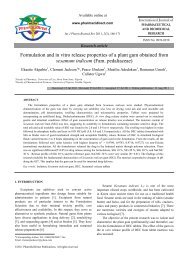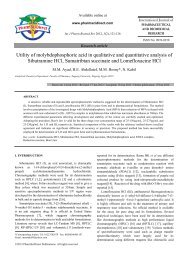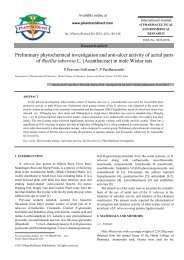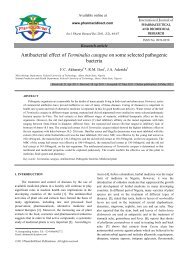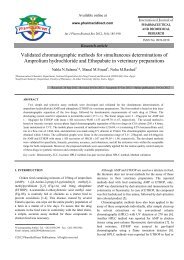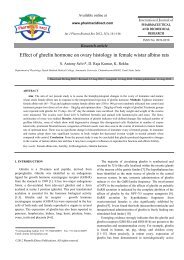Design and development of mucoadhesive buccal ... - PharmSciDirect
Design and development of mucoadhesive buccal ... - PharmSciDirect
Design and development of mucoadhesive buccal ... - PharmSciDirect
You also want an ePaper? Increase the reach of your titles
YUMPU automatically turns print PDFs into web optimized ePapers that Google loves.
Available online at<br />
www.pharmscidirect.com<br />
Int J Pharm Biomed Res 2013, 4(1), 27-33<br />
Research article<br />
International Journal <strong>of</strong><br />
PHARMACEUTICAL<br />
AND BIOMEDICAL<br />
RESEARCH<br />
ISSN No: 0976-0350<br />
<strong>Design</strong> <strong>and</strong> <strong>development</strong> <strong>of</strong> <strong>mucoadhesive</strong> <strong>buccal</strong> tablet <strong>of</strong> labetalol<br />
hydrochloride<br />
Jasvir Singh 1 *, Kanu Saini 2<br />
1 School <strong>of</strong> Pharmaceutical Sciences, Shoolini University, Solan (HP), Oachghat -173 212, India<br />
2 Amar Saheed Baba Ajit Singh Jujhar Singh Memorial College <strong>of</strong> Pharmacy, Bela-Ropar, Punjab-140 111, India<br />
Received: 25 Dec 2012 / Revised: 10 Jan 2013 / Accepted: 15 Jan 2013 / Online publication: 15 Feb 2013<br />
ABSTRACT<br />
The aim <strong>of</strong> the present study is to design <strong>and</strong> <strong>development</strong> <strong>of</strong> <strong>mucoadhesive</strong> <strong>buccal</strong> tablets <strong>of</strong> labetalol hydrochloride.<br />
Since the drug has only 25% oral bioavailability, an attempt was made to develop <strong>mucoadhesive</strong> <strong>buccal</strong> tablets <strong>of</strong> labetalol<br />
hydrochloride to improve the bioavailability <strong>and</strong> therefore to reduce the frequency <strong>of</strong> administration. Tablets were prepared<br />
by direct compression method using Carbopol 934P, HPMC K4M as primary polymer <strong>and</strong> chitosan as secondary polymer in<br />
different drug: polymer ratio. The tablets were evaluated for hardness, weight variation, thickness, percentage drug content,<br />
surface pH, drug-excipients interaction (FTIR). In-vitro studies like swelling index, <strong>mucoadhesive</strong> strength, <strong>and</strong> drug release<br />
were performed. Swelling index was increased with increase with increase in polymer concentration. The in-vitro studies<br />
were carried out at phosphate buffer 6.8 at 37±0.5ºC. The best formulation was selected based on the in vitro drug release<br />
pr<strong>of</strong>ile. The tablet containing drug polymer ratio 1:1.8:1.8 (drug: chitosan: HPMCK4M) was selected as best formulation<br />
which shows the drug release <strong>of</strong> 92% after 8h <strong>and</strong> has bioadhesion strength 12.2g. From the present investigation it may be<br />
concluded that the potential <strong>mucoadhesive</strong> <strong>buccal</strong> tablets <strong>of</strong> labetalol hydrochloride could be prepared by direct compression<br />
method, using chitosan <strong>and</strong> HPMC K4M as a carrier.<br />
Key words: Carbopol 934P, HPMC K4M, Chitosan, In-vitro release studies, Release kinetics.<br />
1. INTRODUCTION<br />
Amongst the various routes <strong>of</strong> drug delivery, the oral<br />
route is most preferred to the patient <strong>and</strong> the clinician alike.<br />
However, oral administration <strong>of</strong> drugs has Disadvantages<br />
such as hepatic first pass metabolism <strong>and</strong> enzymatic<br />
degradation within the gastro intestinal (GIT), that prohibit<br />
oral administration <strong>of</strong> certain classes <strong>of</strong> drugs especially<br />
peptides <strong>and</strong> proteins. Transmucosal routes <strong>of</strong> drug delivery<br />
(mucosal linings <strong>of</strong> nasal, rectal, Vaginal, ocular <strong>and</strong> oral<br />
cavity) <strong>of</strong>fers distinct advantages over oral administration for<br />
Systemic drug delivery. These advantages include possible<br />
bypass <strong>of</strong> first pass effect, Avoidances <strong>of</strong> pre-systemic<br />
elimination within GIT <strong>and</strong> better enzymatic flora for drug<br />
*Corresponding Author. Tel: +91 9023041520 Fax:<br />
Email: saini.jassi666@gmail.com<br />
©2013 <strong>PharmSciDirect</strong> Publications. All rights reserved.<br />
absorption. In <strong>buccal</strong> drug delivery, the <strong>buccal</strong> mucosa is the<br />
preferred region as compared to the sublingual mucosa. One<br />
<strong>of</strong> the reasons is that <strong>buccal</strong> mucosa is less permeable <strong>and</strong> is<br />
thus not able to elicit a rapid onset <strong>of</strong> absorption <strong>and</strong> hence<br />
better suited for formulations that are intended for sustained<br />
release action [1-4].<br />
Within the oral mucosal cavity, the <strong>buccal</strong> region <strong>of</strong>fers<br />
an attractive route <strong>of</strong> administration for controlled systemic<br />
drug delivery. Buccal delivery is the administration <strong>of</strong> drugs<br />
through the mucosal membrane lining the cheeks [5].<br />
Labetalol hydrochloride is an adrenergic antagonist capable<br />
<strong>of</strong> blocking both alpha <strong>and</strong> beta receptor, used in the<br />
treatment <strong>of</strong> hypertension. Labetalol was selected as a model<br />
drug for investigation because <strong>of</strong> its suitable properties like<br />
half-life 4-6h optimum Labetalol Hydrochloride is rapidly<br />
absorbed following an oral dose but undergoes extensive first<br />
pass metabolism, resulting in only 25% oral bioavailability.<br />
The half-life <strong>of</strong> labetalol hydrochloride is approximately<br />
4-6h. Hence, the aim was to prepare a <strong>mucoadhesive</strong> tablet <strong>of</strong>
Jasvir Singh <strong>and</strong> Kanu Saini, Int J Pharm Biomed Res 2013, 4(1), 27-33 28<br />
labetalol hydrochloride to ensure satisfactory drug release in<br />
oral cavity with the use <strong>of</strong> optimum polymer <strong>and</strong> thereby to<br />
avoid first pass metabolism <strong>and</strong> prolong duration <strong>of</strong> action.<br />
So, that it can retain in oral cavity for desired duration <strong>and</strong><br />
localize the dosage form in a specific region <strong>and</strong> control the<br />
release rate <strong>of</strong> drug.<br />
In the present study, the <strong>mucoadhesive</strong> <strong>buccal</strong> tablets <strong>of</strong><br />
labetalol hydrochloride were formulated using the polymers<br />
chitosan, carbopol-934 <strong>and</strong> HPMC K4M.<br />
2. MATERIALS AND METHODS<br />
2.1. Materials<br />
Labetalol hydrochloride was gift sample from Samarth<br />
Pharma, Chitoan from S.D. Fine Chemicals, Mumbai, HPMC<br />
K4M from Colorcon Asia Pvt. Ltd, Carbopol-934P<br />
Qualikems Fine Chemicals Pvt. Ltd.<br />
2.2. Formulation <strong>of</strong> <strong>mucoadhesive</strong> tablets [6]<br />
Mucoadhesive tablets <strong>of</strong> labetalol hydrochloride were<br />
prepared by direct compression technique using different<br />
grades <strong>of</strong> polymer with varying concentrations (Table 1). The<br />
tablets were prepared using Carbopol 934P, HPMC-K4M as<br />
primary polymers <strong>and</strong> Chitosan used as secondary polymer as<br />
a penetration enhancer [5-6]. The effect <strong>of</strong> secondary<br />
polymer on drug release mucoadhesion was studied. The<br />
tablets were compressed using 8mm flat faced punch on a<br />
single stroke punching machine [7-8].<br />
Table 1<br />
Composition <strong>of</strong> labetalol hydrochloride buccoadhesive tablets<br />
Ingredients (mg) F1 F2 F3 F4 F5 F6 F7 F8<br />
Labetalol hydrochloride 50 50 50 50 50 50 50 50<br />
Chitosan 90 60 120 90 60 120 90 60<br />
Carbopol 934 90 120 60 - - - - -<br />
HPMC K4M - - - 90 120 60 - -<br />
Mgnesium stearate 01 01 01 01 01 01 01 01<br />
Lactose qs qs qs qs qs qs qs qs<br />
2.3. Pre-compression evaluation<br />
The formulated blends were examined for their physical<br />
parameters such as bulk density, tapped density, Hausner’s<br />
ratio, compressibility index <strong>and</strong> angle <strong>of</strong> repose (Table 2).<br />
2.4. Post-compression evaluation<br />
The tablets from different formulation (F1 to F8) were<br />
subjected to following tests:<br />
2.4.1. Hardness [7]<br />
Tablets were evaluated for their hardness using Monsanto<br />
hardness tester.<br />
2.4.2. Weight variation<br />
Ten tablets from each formulation were weighed using an<br />
electronic digital balance <strong>and</strong> the average weight was<br />
calculated. The results are shown in Table 3.<br />
2.4.3. Thickness<br />
Tablets were evaluated for their thickness using slide<br />
calipers. The results are shown in Table 3.<br />
2.4.4. Friability<br />
Friability <strong>of</strong> the tablets was determined using Roche<br />
friabilator. This device subjects the tablets to the combined<br />
effect <strong>of</strong> abrasions <strong>and</strong> shock in a plastic chamber revolving<br />
at 25rpm <strong>and</strong> dropping the tablets at a height <strong>of</strong> 6 inch in<br />
each revolution. Pre-weighed sample <strong>of</strong> tablets was placed in<br />
the friabilator <strong>and</strong> were subjected to 100 revolutions. Tablets<br />
were de dusted using a s<strong>of</strong>t muslin cloth <strong>and</strong> reweighed. The<br />
friability (F %) is given by the formula:<br />
% 1 <br />
100<br />
where, W 0 is weight <strong>of</strong> the tablets before the test <strong>and</strong> W is the<br />
weight <strong>of</strong> the tablets after test<br />
2.4.5. Drug content [8]<br />
Three tablets from each batch were taken in separate<br />
100mL volumetric flaks containing 100mL <strong>of</strong> pH 6.8<br />
phosphate buffer <strong>and</strong> were kept for 24h under constant<br />
stirring. The solutions were then filtered, diluted suitably <strong>and</strong><br />
analyzed at 302nm using UV-spectrophotometer. The<br />
average <strong>of</strong> three tablets was taken as the content <strong>of</strong> drug in<br />
one tablet unit.<br />
2.4.6. Surface pH [9]<br />
The surface pH <strong>of</strong> the <strong>buccal</strong> tablets was determined in<br />
order to investigate the possibility <strong>of</strong> any in-vivo side effects.<br />
An acidic or alkaline pH may cause irritation to the <strong>buccal</strong><br />
mucosa. The method developed by Battenberg et al was used.<br />
A combined glass electrode was used for this purpose. The<br />
tablets were allowed to swell by keeping it in contact with<br />
distilled water (pH 6.5 ± 0.05) for 2h at room temperature.<br />
The pH was measured by bringing the electrode in contact<br />
with the surface <strong>of</strong> the tablet <strong>and</strong> allowing it to equilibrate for<br />
1min. The results are shown in Table 4.
Jasvir Singh <strong>and</strong> Kanu Saini, Int J Pharm Biomed Res 2013, 4(1), 27-33<br />
29<br />
Table 2<br />
Evaluation parameter <strong>of</strong> pre-compression blend<br />
Formulation code Bulk density (g/mL)<br />
F1<br />
0.434±0.04<br />
F2<br />
0.440±0.08<br />
F3<br />
0.431±.02<br />
F4<br />
0.437±0.07<br />
F5<br />
0.442±0.09<br />
F6<br />
0.427±0.01<br />
F7<br />
0.446±0.08<br />
F8<br />
0.434±0.02<br />
Tapped density (g/mL)<br />
0.490±0.100<br />
0.518±0.03<br />
0.498±0.13<br />
0.526±0.08<br />
0.549±0.111<br />
0.495±0.17<br />
0.515±0.055<br />
0.537±0.100<br />
Compressibility index (%) Hausner’s ratio<br />
11.42±2.1<br />
1.129±0.04<br />
15.05±1.9<br />
1.177±0.02<br />
13.45±0.6<br />
1.155±0.02<br />
16.92±1.6<br />
1.20± ±0.40<br />
19.48±0.63<br />
1.24± ±0.031<br />
13.73±0.43<br />
1.159±0.47<br />
13.39±1.4<br />
1.54± ±0.21<br />
19.18±1.3<br />
1.23± ±0.45<br />
Angle <strong>of</strong> repose (º)<br />
30.11±3.1º<br />
29.68±2.3º<br />
30.96±1.6º<br />
28.36±1.2º<br />
33.42±2.1º<br />
33.02±2.5º<br />
31.42±1.0 º<br />
31.79±1.4º<br />
Table 3<br />
Evaluation parameter <strong>of</strong> post-compression tablet<br />
Formulation<br />
code<br />
F1 F2 F3 F4 F5 F6 F7 F8 Weight variation<br />
(mg)<br />
503±5.2<br />
500±10.9<br />
502±4.4<br />
500±4.5<br />
504±7.1<br />
501±3.3<br />
500±4.7<br />
504±2.6<br />
Hardness<br />
(kg/cm2 )<br />
4.4±0.3<br />
4.4±0.2<br />
4.5±0.4<br />
5.0±0.3<br />
4.5±0.34<br />
4.0±0.1<br />
4.0±0.2<br />
5.0±0.2<br />
Friability<br />
(%)<br />
0.455±0.12 0.425±0.3 0.575±0.2 0.40±0.27 0.60±0.07 0.42±0.52 0.61±0.42 0.62±0.71 Thickness<br />
(mm)<br />
4.24± ±0.005<br />
4.24± ±0.01<br />
4.24± ±.005<br />
4.24± ±0.04<br />
4.24± ±.005<br />
4.24± ±.005<br />
4.24± ±0.01<br />
4.24± ±0.01<br />
Table 4<br />
Evaluation parameters <strong>of</strong> <strong>mucoadhesive</strong> strengths <strong>and</strong> surface pH<br />
Formulation code<br />
F1<br />
F2<br />
F3<br />
F4<br />
F5<br />
F6<br />
F7<br />
F8<br />
(n=3, Mean ±SD)<br />
Mucoadhesive strength (g)<br />
12.77±0.5<br />
14.28±0.35<br />
11.45±0.28<br />
12.2±0. .39<br />
11.43±0.33<br />
8.65±0. .31<br />
8.08±0. .40<br />
7.50±0. .45<br />
Surface pH<br />
6.5±0.15<br />
6.4±0.99<br />
6.5±0.15<br />
6.5±0.11<br />
6.5±0.17<br />
6.5±0.09<br />
6.5±0.17<br />
6.6±0.20<br />
% Swelling index<br />
300<br />
250<br />
200<br />
150<br />
100<br />
50<br />
0<br />
0 2 4 6 8<br />
Time (h)<br />
Fig.1. Percentage swelling index <strong>of</strong> <strong>buccal</strong> tablets versus time<br />
F1<br />
F2<br />
F3<br />
F4<br />
F5<br />
F6<br />
F7<br />
F8<br />
10<br />
2. .4.7. In-vitro swelling studies [10]<br />
The degreee <strong>of</strong> swelling <strong>of</strong> bio‐adhesive polymers<br />
is an<br />
important factor affecting adhesive. For conducting the<br />
study,<br />
a tablet was weighed <strong>and</strong> placed in a petri‐dish containing<br />
5mL <strong>of</strong> phosphate buffer at pH 6.8 for 12h, the tablets were<br />
taken out from<br />
the petri‐dish<br />
<strong>and</strong> excess water was removed<br />
carefully by using filter paper. The swelling index was<br />
calculated using the following formula <strong>and</strong> results are shown<br />
in<br />
Fig.1.<br />
Fig.2. Bioadhesion testing instrument<br />
% Swelling index Wet w eight Dry weight 100<br />
Wet weight<br />
2. .4.8. In vitro <strong>mucoadhesive</strong>e study<br />
The tensilee strength required to detach the polymeric<br />
patch from the mucosal surface was applied as measuree <strong>of</strong> the<br />
bioadhesive performance.<br />
Instrument: The apparatus was locally assembled <strong>and</strong><br />
was a<br />
modification <strong>of</strong> the physical balance apparatus (Fig.2). The<br />
device was mainly composed<br />
<strong>of</strong> a two-arm<br />
balance. The left<br />
arm<br />
<strong>of</strong> the balance was replaced by the petri-dish vertically<br />
suspended through a 3 threads. At the same side, the <strong>buccal</strong><br />
mucosa <strong>of</strong> goat is attached to both petri-dishes.<br />
Method: The fabricated balance described above was used for<br />
the<br />
bioadhesion<br />
studies. The goat <strong>buccal</strong> mucosa, excised <strong>and</strong><br />
washed<br />
was fixed to the movable<br />
platform. The<br />
<strong>mucoadhesive</strong><br />
tablet was fixed to petri-dish by using<br />
‘cyanoacrylate’<br />
as adhesive. The exposed<br />
tablet surface was<br />
moistened with 1mL <strong>of</strong> isotonic phosphate buffer for 30sec<br />
for<br />
initial hydration <strong>and</strong> swelling. The platform was<br />
then
Jasvir Singh <strong>and</strong> Kanu Saini, Int J Pharm Biomed Res 2013, 4(1), 27-33 30<br />
Table 5<br />
In vitro release <strong>of</strong> labetalol hydrochloride <strong>buccal</strong> tablet<br />
Time<br />
Formulation code<br />
F1 F2 F3 F4 F5 F6 F7 F8<br />
0.5h 2.9±0.2 1.7±0.8 2.2±0.6 3.5±1.7 3.8±1.3 2.9±1.2 5.7±1.6 3.0±0.9<br />
1h 4.5±0.3 5.9±1.7 4.8±1.6 16.2±1.8 12.6±2.2 6.7±1.6 8.0±3.4 11.2±4.3<br />
2h 14.1±0.4 10.9±2.4 13.7±3.9 31.5±1.2 25.3±3.8 14.4±1.2 29.3±0.8 28.4±2.4<br />
3h 25.1±1.1 15.6±1.7 22.0±5.8 53.8±4.6 35.8±4.0 23.3±2.1 53.8±4.1 49.2±3.1<br />
4h 31.4±0.6 24.6±2.9 34.2±4.8 60.7±5.6 39.8±5.0 33.1±2.3 71.2±2.7 68.4±0.3<br />
5h 45.9±3.1 29.3±1.8 43.5±5.3 69.3±3.1 47.7±3.8 39.9±2.3 73.6±1.6 70.3±1.5<br />
6h 54.6±1.0 35.5±3.6 53.6±4.9 76.4±3.4 59.4±0.7 52.7±3.6 63.7±1.9 75.7±1.6<br />
7h 60.9±1.4 42.5±1.9 62.9±2.3 84.2±1.4 71.4±0.3 63.7±1.9 Discarded due to release <strong>of</strong> drug<br />
8h 67.6±1.2 50.3±2.1 70.8±0.9 92.1±0.8 81.5±0.7 75.7±1.6 before time<br />
Table 6<br />
Effect <strong>of</strong> storage condition on optimized tablet (F4)<br />
Days Weight (mg) Surface pH Mucoadhesive<br />
strength (g)<br />
% Drug<br />
content<br />
0 505.50 6.5 12.2 97.08<br />
30 505.47 6.4 12.1 97.05<br />
60 505.42 6.4 12.0 97.03<br />
90 505.30 6.3 12.0 97.0<br />
powders were mixed separately with IR grade KBr <strong>and</strong><br />
pellets were prepared by applying a pressure <strong>of</strong> 10 tons in a<br />
hydraulic press. The pellets were scanned over a wavelength<br />
range <strong>of</strong> 400 to 4000cm ‐1 using an FTIR instrument.<br />
Drug‐excipients interactions play a vital role in the release <strong>of</strong><br />
drug from formulations. FTIR techniques have been used to<br />
study the physical <strong>and</strong> chemical interactions between drug<br />
<strong>and</strong> excipients used.<br />
% Cumulative drug release<br />
100<br />
90<br />
80<br />
70<br />
60<br />
50<br />
40<br />
30<br />
20<br />
10<br />
0<br />
% CDR (o day)<br />
%CDR (90 days)<br />
0 2 4 6 8 10<br />
Time (h)<br />
Fig.3. Comparison <strong>of</strong> drug release before <strong>and</strong> after storage<br />
2.4.10. In-vitro release studies [12]<br />
Various apparatus has been designed to study dissolution<br />
rate <strong>and</strong> in vitro release rate pr<strong>of</strong>ile <strong>of</strong> drug from bioadhesive<br />
drug delivery systems <strong>and</strong> tablets. The study was carried out<br />
in USP II apparatus, employed paddle stirrer at 50rpm <strong>and</strong><br />
900mL <strong>of</strong> phosphate buffer pH 6.8 as dissolution medium<br />
maintained at 37±0.5°C. The tablets were supposed to release<br />
drug from one side only hence a one side <strong>of</strong> tablets was fixed<br />
a glass disk with cyanoacrylate adhesive. The disk was<br />
placed at the bottom <strong>of</strong> dissolution vessel. An aliquots <strong>of</strong><br />
5mL was withdrawn at 0.5, 1, 2, 3, 4, 5, 6, 7 <strong>and</strong> 8 th h <strong>and</strong><br />
replaced with fresh medium. The samples were filtered <strong>and</strong><br />
analyzed it at 302nm using UV-Visible spectroscopy <strong>and</strong> the<br />
results were summarized as in Table 5.<br />
raised upward until the hydrated patch was brought into the<br />
contact with the mucosal surface. A preload <strong>of</strong> 20g was<br />
placed over the petri-dish surface for 3min as initial pressure<br />
to attach the <strong>buccal</strong> mucosa with tablet. And then weights<br />
were slowly increased on the right pan, till the patch detaches<br />
from the mucosal membrane. The weight required to detach<br />
the patch from the mucosa give the bioadhesive strength <strong>of</strong><br />
the <strong>mucoadhesive</strong> patch. The procedure is repeated for 3<br />
times for each patch <strong>and</strong> mean value <strong>of</strong> the 3-trials was taken<br />
for each set <strong>of</strong> formulation. After each measurement the<br />
tissue was gently <strong>and</strong> thoroughly washed with isotonic<br />
phosphate buffer <strong>and</strong> left for 5min before taking reading.<br />
2.4.9. Interaction studies [11]<br />
The pure drug, labetalol hydrochloride <strong>and</strong> its mixture<br />
with the polymer Chitosan, HPMC K4M <strong>and</strong> Carbopol 934P<br />
2.4.11. Stability studies [13]<br />
Most recently a guideline issued by the International<br />
Conference on Harmonization (ICH, 1993) indicates that the<br />
purpose <strong>of</strong> stability testing is to provide evidence on how the<br />
quality <strong>of</strong> a drug substance or the drug product varies with<br />
time under the influence <strong>of</strong> variety <strong>of</strong> environmental factors,<br />
such as temperature, humidity <strong>and</strong> light, <strong>and</strong> enables<br />
recommended storage conditions, retest periods, to be<br />
established.<br />
Short term stability studies were performed at a<br />
temperature o <strong>of</strong> 40±2°C/75±5%RH over a period <strong>of</strong> 3 month<br />
(90 days) on the promising <strong>buccal</strong> tablet <strong>of</strong> labetalol<br />
hydrochloride. Sufficient number <strong>of</strong> tablets (15) were packed<br />
in amber coloured rubber stopper vials <strong>and</strong> kept in stability<br />
chamber maintained at 40±2°C/75±5%RH. At intervals <strong>of</strong> 1<br />
month, the tablets were visually examined for any physical<br />
changes, changes in weight, surface pH, <strong>mucoadhesive</strong>
Jasvir Singh <strong>and</strong> Kanu Saini, Int J Pharm Biomed Res 2013, 4(1), 27-33 31<br />
80.8<br />
75<br />
70<br />
65<br />
60<br />
2526.67<br />
946.08<br />
1011.32<br />
900.81<br />
1148.08<br />
1120.81<br />
1035.64<br />
1323.37<br />
1310.97<br />
1212.36<br />
753.00<br />
666.88<br />
521.28<br />
453.31<br />
%T<br />
55<br />
50<br />
45<br />
2752.08<br />
2805.43<br />
2980.97<br />
3029.12<br />
3066.16<br />
1602.56<br />
1580.99<br />
1389.78<br />
1499.33<br />
1437.93<br />
1641.35<br />
1415.56<br />
1251.83<br />
1268.11<br />
1063.48<br />
824.59<br />
698.10<br />
588.32<br />
40<br />
3355.00<br />
35<br />
3189.57<br />
1674.40<br />
30.0<br />
4000.0 3600 3200 2800 2400 2000 1800 1600 1400 1200 1000 800 600 400.0<br />
cm-1<br />
Fig.4. Observed spectra <strong>of</strong> labetalol hydrochloride<br />
70.4<br />
, g<br />
65<br />
%T<br />
60<br />
55<br />
50<br />
45<br />
40<br />
35<br />
2752.29<br />
2858.52<br />
2807.29<br />
3029.06<br />
2981.13<br />
3087.60<br />
3066.06<br />
522.22<br />
452.53<br />
945.54<br />
900.07<br />
1148.09<br />
752.92<br />
1211.96<br />
666.90<br />
1323.32 1120.28<br />
1311.11 1105.67<br />
1034.97<br />
698.44 588.64<br />
825.42<br />
1602.29<br />
1063.29<br />
1581.01<br />
1251.59<br />
1268.08<br />
1499.21<br />
1438.37<br />
1389.49<br />
1641.21 1415.67<br />
3354.85<br />
30<br />
3189.71<br />
25.0<br />
1674.28<br />
4000.0 3600 3200 2800 2400 2000 1800 1600 1400 1200 1000 800 600 400.0<br />
cm-1<br />
Fig.5. IR Spectra <strong>of</strong> mixture <strong>of</strong> labetalol hydrochloride + Chitosan<br />
77.5<br />
76<br />
, g<br />
74<br />
72<br />
70<br />
909.01<br />
723.08<br />
751.98<br />
516.24<br />
453.54<br />
68<br />
946.21<br />
668.48<br />
%T<br />
66<br />
64<br />
62<br />
2944.05<br />
1602.85<br />
1581.00<br />
1323.67<br />
1311.21 1148.25<br />
1212.14<br />
1120.99<br />
1035.35<br />
825.46<br />
697.86<br />
588.06<br />
60<br />
58<br />
1641.26<br />
1499.28<br />
1251.56<br />
1437.55 1268.28<br />
1389.54<br />
1063.27<br />
56<br />
1415.57<br />
54<br />
52<br />
3355.66<br />
50<br />
3190.10<br />
1674.45<br />
48.0<br />
4000.0 3600 3200 2800 2400 2000 1800 1600 1400 1200 1000 800 600 400.0<br />
cm-1<br />
Fig.6. IR Spectra <strong>of</strong> mixture <strong>of</strong> labetalol hydrochloride + HPMC K4M<br />
81.7<br />
80<br />
78<br />
76<br />
74<br />
72<br />
70<br />
1581.05<br />
1499.31<br />
1310.35<br />
944.28<br />
904.97<br />
1119.49<br />
1034.82<br />
1062.50<br />
519.82<br />
452.90<br />
753.64<br />
665.90<br />
698.49<br />
589.12<br />
%T<br />
68<br />
66<br />
1389.49<br />
1211.00<br />
823.59<br />
64<br />
62<br />
3354.76<br />
2951.51<br />
1641.71<br />
1710.17<br />
1438.90<br />
1415.34<br />
1266.64<br />
60<br />
58<br />
3189.46<br />
56<br />
1674.90<br />
55.0<br />
4000.0 3600 3200 2800 2400 2000 1800 1600 1400 1200 1000 800 600 400.0<br />
cm-1<br />
Fig.7. IR Spectra <strong>of</strong> mixture <strong>of</strong> labetalol hydrochloride + Carbopol 934
Jasvir Singh <strong>and</strong> Kanu Saini, Int J Pharm Biomed Res 2013, 4(1), 27-33 32<br />
strength <strong>and</strong> drug content <strong>and</strong> at the end <strong>of</strong> 3 month period<br />
(Table 6); they were also tested for in vitro drug release<br />
pattern (Fig.3).<br />
3. RESULT AND DISCUSSION<br />
In the present project <strong>buccal</strong> tablets <strong>of</strong> labetalol<br />
hydrochloride were prepared <strong>and</strong> evaluated for achievement<br />
<strong>of</strong> extend release action <strong>of</strong> active moiety. The tablets were<br />
prepared by direct compression method using varying<br />
concentration <strong>of</strong> polymers. These prepared tablets were<br />
evaluated for their various quality control parameters.<br />
The pure drug was confirmed by chemical test as<br />
prescribed in IP (2007). The melting point <strong>of</strong> obtained sample<br />
was found to be 195 o C. The IR Spectra <strong>of</strong> obtained sample<br />
drug was concordant with reference spectra as given in IP<br />
(2007). Their important chromospheres groups elucidated the<br />
IR Spectra. The various peaks were depicted in Fig.4-Fig.7.<br />
The IR Spectra verified the authenticity <strong>of</strong> the obtained<br />
sample.<br />
The solubility <strong>of</strong> labetalol hydrochloride was determined<br />
in phosphate buffer. The solubility was found in phosphate<br />
buffer (pH 6.8) was 80±0.57μg/mL. The IR Spectra <strong>of</strong> the<br />
various mixtures reveal all the peak <strong>of</strong> the drug. No<br />
significant shifts in the peaks corresponding to the drug were<br />
observed on the mixing. Hence the drug <strong>and</strong> polymers can be<br />
successfully incorporated in the design <strong>of</strong> <strong>buccal</strong> tablets.<br />
The formulated blends <strong>and</strong> prepared tablets were<br />
examined for their physical properties. The various<br />
parameters were evaluated such as bulk density, tapped<br />
density, Hausner’s ratio, compressibility index <strong>and</strong> angle <strong>of</strong><br />
repose. After compression <strong>of</strong> blend, the tablets were<br />
evaluated for their physical organoleptic properties (colour,<br />
odour, taste) <strong>and</strong> quality control parameter (thickness,<br />
hardness <strong>and</strong> friability). All the formulations were white in<br />
colour, odourless, flat in shape with smooth surface without<br />
any defects. The prepared tablets were elegant <strong>and</strong> having lot<br />
to lot tablet uniformity <strong>and</strong> also frees from any surface<br />
texture problems.<br />
The bulk density <strong>of</strong> mixed blend varied between<br />
0.427±0.01 to 0.442±0.09g/mL. The results indicate good<br />
packaging capacity <strong>of</strong> tablets. The tapped density was found<br />
in the range <strong>of</strong> 0.490±0.10 to 0.549±0.11mg/mL. The<br />
compressibility index was found in between 11.42±2.1 to<br />
19.48±0.11. The angle <strong>of</strong> repose was found to be 28.36±1.2<br />
to 33.42±2.12°. The results for characterization <strong>of</strong> blend <strong>of</strong><br />
<strong>buccal</strong> tablets labetalol hydrochloride tablets were shown in<br />
Table 2. This result indicates the good flow property <strong>of</strong> the<br />
mixed blend.<br />
The hardness <strong>of</strong> prepared <strong>mucoadhesive</strong> <strong>buccal</strong> tablets<br />
was from 4.0±0.1 to 5.0±0.3kg/cm 2 . The thickness <strong>of</strong> the<br />
tablets was found 4.24±0.1 to 4.24±0.4mm. All prepared<br />
tablets complies the Indian Pharmacopoeia st<strong>and</strong>ard for<br />
weight variation <strong>and</strong> friability. The drug content was from<br />
90±0.1to 97.2±0.4% suggested uniform mixing <strong>of</strong> drug. The<br />
surface pH for all the <strong>buccal</strong> tablets was from 6.4 to 6.6<br />
which was near to salivary pH (6.5-7.5) suggesting that the<br />
prepared <strong>buccal</strong> tablets can used without the risk <strong>of</strong> mucosal<br />
irritation <strong>and</strong> discomfort.<br />
The swelling study <strong>of</strong> prepared <strong>buccal</strong> tablets was<br />
performed in phosphate buffer pH 6.8 <strong>and</strong> the results are<br />
prepared as percentage weight change with respect to time in<br />
Table 3. The swelling <strong>of</strong> all the tablets was increased as the<br />
time proceeds because the polymers gradually absorb water<br />
due to hydrophilicity to the polymer. After 8h the swelling<br />
index <strong>of</strong> the different formulations was within the range <strong>of</strong><br />
160.3 to 243.9%. The chitosan is insoluble in aqueous media<br />
<strong>of</strong> pH 6.8 but absorb large quantity <strong>of</strong> water <strong>and</strong> hence<br />
formulation <strong>of</strong> gel. The swelling was getting affected in the<br />
formulation containing secondary polymer chitosan. The<br />
percent swelling index determined at 0.5, 1, 2, 3, 4, 5, 6, 7<br />
<strong>and</strong> 8h <strong>and</strong> it was increased with an increase polymer<br />
concentration with respect to time. The general trend<br />
suggested an increase in percent swelling index with an<br />
increase in the hydrophilic polymer. Chitosan-Carbopol 934P<br />
<strong>buccal</strong> tablets showed the greatest swelling (F3 – 51.4% in<br />
1h) followed by (Fig.2).<br />
In vitro drug release experiments were performed at<br />
37±1 o C in U.S.P II dissolution apparatus. The results showed<br />
that all the formulations release the drug within 0.5 to 8h.<br />
The maximum drug release was found in formulation F4<br />
(92.1±1.2 %) within 8h. The order <strong>of</strong> drug release was found<br />
to be: F4>F5 >F6 >F7 >F3 >F8>F1>F2. Formulations F1,<br />
F2, F3 which contain Chitosan-Carbopol 934P in varying<br />
concentration <strong>and</strong> the release were found to be after the 8h<br />
67.6, 50.3, <strong>and</strong> 75.8% respectively. The drug release was<br />
found to be 92.1, 81.5 <strong>and</strong> 75.7% respectively for the<br />
formulations F4, F5, F6. The formulation F7 <strong>and</strong> F8 were<br />
discarded because they release the drug before time.<br />
The strength <strong>of</strong> the formulation (tablet) was depends on<br />
the property <strong>of</strong> <strong>mucoadhesive</strong> polymers, which adhere to the<br />
mucosal surface <strong>and</strong> also the concentration <strong>of</strong> polymers used.<br />
The highest bond strength was possessed by the formulation<br />
F2 containing Chitosan <strong>and</strong> Carbopol 934P in the ratio <strong>of</strong> 1:2.<br />
Decrease the content <strong>of</strong> the Carbopol 934P resulted in<br />
decreased adhesion force. Table 4 deposits the mean values<br />
<strong>of</strong> in-vitro bioadhesivity (g) <strong>of</strong> the polymeric tablets. The<br />
bioadhesivity increased with an increase in hydrophilic<br />
polymers.<br />
The obtained release data were subjected for the kinetic<br />
treatment to know the type <strong>and</strong> order <strong>of</strong> drug release. The invitro<br />
release data was subjected to zero order, first order,<br />
Higuchi <strong>and</strong> Korsemeyer-Peppas model in order to establish<br />
the drug release mechanism <strong>and</strong> kinetics <strong>of</strong> drug release from<br />
the <strong>buccal</strong> tablets. The regression analysis which correlation<br />
coefficient ‘r 2 ’ values for different kinetic model is<br />
summarized in Table 7. When the data was subjected to zero<br />
order <strong>and</strong> first order kinetic model, a linear relationship was<br />
observed with high ‘r 2 ’ value for zero order as compared to<br />
first order model suggested that the formulation was zero<br />
order controlled release. Higuchi’s model was applied to the<br />
in vitro release data, linearity was obtained with high
Jasvir Singh <strong>and</strong> Kanu Saini, Int J Pharm Biomed Res 2013, 4(1), 27-33 33<br />
Table 7<br />
Release kinetics studies<br />
Formulation Zero order First order Higuchi Korsmeyer-Peppas<br />
code<br />
r 2 r 2 r 2 r 2 n<br />
F1 0.985 0.946 0.877 0.991 0.852<br />
F2 0.990 0.974 0.869 0.992 0.912<br />
F3 0.993 0.959 0.898 0.994 0.819<br />
F4 0.923 0.976 0.898 0.962 0.951<br />
F5 0.979 0.969 0.876 0.988 0.866<br />
F6 0.984 0.909 0.881 0.993 0.907<br />
F7 0.952 0.908 0.868 0.954 0.835<br />
F8 0.965 0.922 0.874 0.954 0.821<br />
‘r 2 ’ value suggested that the drug release from tablet follow<br />
diffusion mechanism as all the polymer used were gel based<br />
matrix type. Korsemeyer-Peppas model was applied which<br />
will define exact release mechanism when more than one<br />
type <strong>of</strong> release phenomenon was observed. Good linearity<br />
with high ‘r 2 ’ value was observed with Korsemeyer-Peppas<br />
model. The values <strong>of</strong> release exponent ‘n’ calculated as a<br />
slope define the release mechanism. The value <strong>of</strong> ‘n’<br />
obtained for all the tablets formulation was ˃0.5 <strong>and</strong>˂1.0<br />
suggested that the drug release followed non- fickian<br />
anomalous dissolution due to higher affinity <strong>of</strong> hydrophilic<br />
polymers towards water.<br />
4. CONCLUSIONS<br />
From the present investigation it may be concluded that<br />
the potential <strong>mucoadhesive</strong> <strong>buccal</strong> tablets <strong>of</strong> labetalol<br />
hydrochloride could be prepared by direct compression<br />
method, using chitosan <strong>and</strong> HPMC K4M as a carrier. The<br />
best formulation was selected based on the in vitro drug<br />
release pr<strong>of</strong>ile. The best formulation, F4 which contains drug<br />
polymer ratio <strong>of</strong> 1:1.8:1.8 (drug: chitosan: HPMCK4M)<br />
shows the prolonged drug release upto 8h. Further, the best<br />
formulation can be manufactured with consistent<br />
reproducible physical <strong>and</strong> dissolution characteristics <strong>and</strong><br />
compared to that <strong>of</strong> a reputed marketed product. Further<br />
pharmacodynamic <strong>and</strong> pharmacokinetic studies should be<br />
carried out for the best formulation <strong>and</strong> compared with the<br />
marketed product.<br />
ACKNOWLEDGMENT<br />
Authors wish to give thanks to School <strong>of</strong> Pharmaceutical<br />
Sciences, Shoolini University, Solan, <strong>and</strong> authority for<br />
providing suitable research laboratory to carry out this project<br />
work <strong>and</strong> also my deep greatness to Samarth Pharma,<br />
Nalagarh, India, for providing gift sample <strong>of</strong> labetalol<br />
hydrochloride.<br />
REFERENCES<br />
[1] Tripathi, K.D., Essentials <strong>of</strong> Medical Pharmacology, 6 th Edn., J.P.<br />
Medical Publishers, New Delhi 2008.<br />
[2] Goodman <strong>and</strong> Gilman’s. The Pharmacological Basis <strong>of</strong> Therapeutics,<br />
10 th Edn., Medical Publishing Division, New York 2001.<br />
[3] G<strong>and</strong>hi, P.A., Patel, M.R., Patel, K.R., Patel, N.M., Int J Pharma Res<br />
Deliv 2011, 3, 159-173.<br />
[4] Satyabrata Bhanja, Ellaiah, P., Sujit Kumar Martha, Pratit Kanchan<br />
Sahu, S<strong>and</strong>ip Prasad Tiwari, Bibhuti Bhusan Panigrahi et al., Int J<br />
Pharm Biomed Res 2010, 1, 129-134.<br />
[5] Venkatalakshmi, R., Yajaman, S., Chetty, M., Sasikala, C., Mohan<br />
Varma, M., Int J Pharm Sci Res 2012, 3, 35-41.<br />
[6] Lewis, S., Subramanian. G., P<strong>and</strong>ey, S., Udupa, N., Ind J Pharm Sci<br />
2006, 68, 829-831.<br />
[7] Vaidya, V., Manwar, J., Sakarkar, D., Int J Pharam Tech Res 2009, 1,<br />
588-597.<br />
[8] Zhang, L., Li, N., Zhao, F., Li, K., Ana Sci 2004, 20, 445-450.<br />
[9] Pramod Kumar, T.M., Shivakumar, H.G., Asian J Pharm Sci 2006, 1,<br />
175-187.<br />
[10] Indian Pharmacopoeia-Vol. II, Controller <strong>of</strong> Publications, Delhi 1996,<br />
pp. 629-631.<br />
[11] European Pharmacopoeia, 3 rd Edn., Council <strong>of</strong> Europe, Strasbourg<br />
1997, pp. 997-998.<br />
[12] Velmurugan, S., Deepika, B., Nagaraju, K., Vinushitha, S., Int J Pharm<br />
Tech Res 2010, 2, 1958-1968.<br />
[13] United States Pharmacopoeia, United State Pharmacopoeial<br />
Convention, Vol.19, Rockville 2000, pp. 1913-1914.


